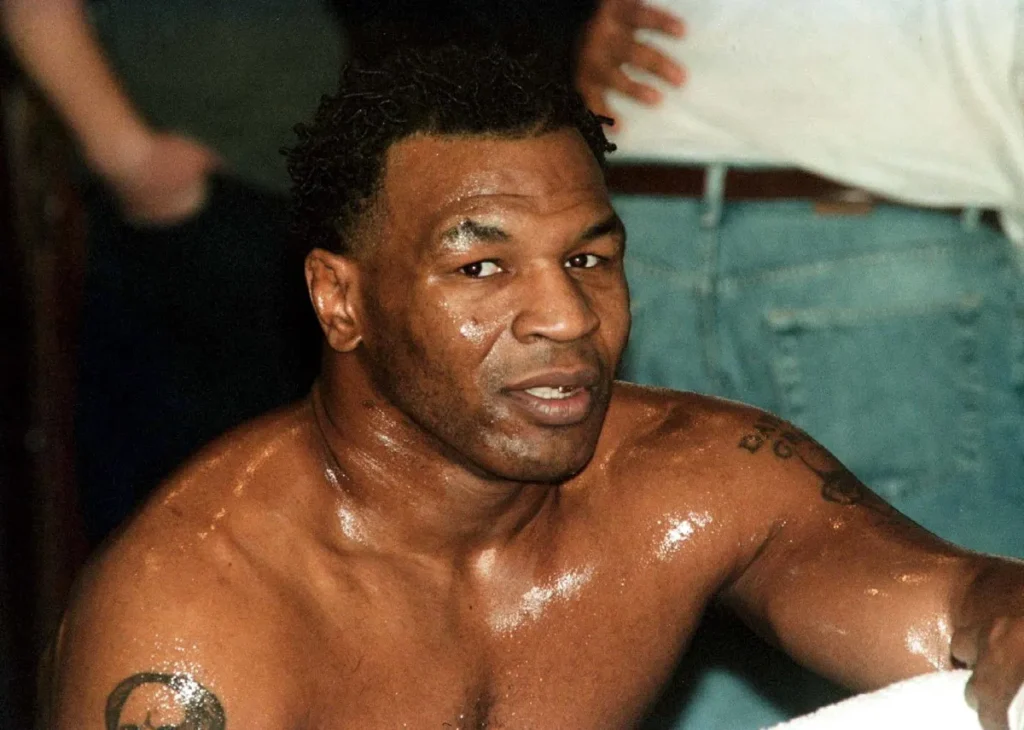Mike Tyson Neck Workout: Building Strength Like a Champ:

Ever wondered how Mike Tyson maintained such an imposing presence in the ring? One of his secrets lies in his neck workout routine. A strong neck not only enhances your physical appearance but also plays a crucial role in overall athletic performance and injury prevention. In this article, we’ll delve into the intricacies of Mike Tyson’s neck workout, exploring its benefits, exercises, and how you can incorporate it into your fitness regimen.
Table of Contents
When active, Mike Tyson was a brute force to deal with. His ferocious and no-nonsense approach to boxing evoked fear among the opponents. Every time the American stepped into the ring, he brought violence and utter disregard for defensive boxing. However, his stellar rise was not limited to his explosive power but also his ability to absorb punches and a strong chin, especially his 20-inch neck.
The visuals of ‘Kid Dynamite’ walking to the boxing ring in a towel-cut terrified many. A similar case can be made for his insanely thick neck, which puzzled many. The former heavyweight champion is a freak of nature, partly attributed to his genetics and partly to his intense training. Undoubtedly, genetics plays an important role in determining body structure, resulting in a larger neck circumference. But Tyson’s grueling training regime most probably contributed to his steel-esque, powerful neck muscles.
Benefits of a Strong Neck
Injury Prevention
A robust neck can help prevent injuries, particularly in high-impact sports. Strengthening the neck muscles provides better support for the head, reducing the risk of whiplash and concussions.
Improved Athletic Performance
Athletes with strong necks often perform better in their respective sports. A powerful neck can improve balance, stability, and overall strength, contributing to enhanced athletic performance.
Enhanced Posture
Neck training can also improve posture. A strong neck supports the spine and head, promoting better alignment and reducing strain on other muscles.
Mike Tyson: A Brief Overview

Early Life and Career
Mike Tyson, born in 1966, quickly rose to fame as one of the most formidable boxers in history. Known for his incredible power and ferocity in the ring, Tyson became the youngest heavyweight champion at the age of 20.
Achievements and Milestones
Throughout his career, Tyson achieved numerous accolades, including winning the WBC, WBA, and IBF titles. His physical attributes, particularly his powerful neck, played a significant role in his success.
Physical Attributes
Tyson’s neck was notably thick and muscular, contributing to his overall intimidating physique. This wasn’t just for show; a strong neck is crucial for absorbing punches and maintaining balance during a fight.
The Science Behind Neck Training
Anatomy of the Neck Muscles
The neck comprises several muscles, including the sternocleidomastoid, trapezius, and levator scapulae. Training these muscles can enhance strength, stability, and endurance.
How Neck Training Works
Neck training involves exercises that target these muscles, promoting hypertrophy and strength. Consistent training can lead to significant improvements in neck muscle size and function.
Benefits of Neck Strength in Combat Sports
In combat sports like boxing, a strong neck is essential. It helps fighters absorb blows better, maintain balance, and reduce the risk of knockouts.
Mike Tyson’s Neck Workout Routine
Overview of the Workout
Tyson’s neck workout is both intense and effective. It includes a variety of exercises designed to target all the major neck muscles, ensuring comprehensive development.
Frequency and Duration
Typically, Tyson’s neck workout was performed several times a week, with each session lasting about 20-30 minutes. Consistency and gradual progression are key to seeing results.
Detailed Breakdown of Exercises
Neck Bridges
Execution
To perform neck bridges, lie on your back with your knees bent. Lift your hips off the ground, supporting your weight on your head and feet. Hold for a few seconds and repeat.
Benefits
Neck bridges are excellent for building overall neck strength and stability. They also improve flexibility and endurance.
Neck Curls
Execution
Lie on a bench with your head hanging off the edge. Using a weight plate, perform slow and controlled curls, lifting your chin towards your chest.
Benefits
Neck curls target the front of the neck, enhancing muscle size and strength.
Resistance Band Exercises
Execution
Attach a resistance band to a stable object. Perform various movements, such as neck flexion, extension, and lateral flexion, using the resistance band for added resistance.
Benefits
Resistance band exercises are versatile and effective for targeting different neck muscles.
Weighted Neck Exercises
Execution
Using a neck harness, attach weights and perform exercises like neck extensions and lateral flexions. Start with light weights and gradually increase as you build strength.
Benefits
Weighted exercises are great for adding resistance and promoting muscle growth.
Safety Tips for Neck Training
Proper Warm-up Techniques
Always warm up before neck training to prevent injuries. Gentle stretches and light exercises can help prepare the muscles.
Importance of Form
Maintaining proper form is crucial to avoid strain and injuries. Focus on controlled movements and avoid jerking or sudden motions.
How to Avoid Common Injuries
Listen to your body and avoid pushing yourself too hard. Gradual progression and proper technique are key to preventing injuries.
Additional Tips for Neck Training
Gradual Progression
Start with light weights and low resistance, gradually increasing as your strength improves.
Incorporating Neck Training into Your Routine
Add neck exercises to your regular workout routine, ensuring balanced development of all muscle groups.
Importance of Rest and Recovery
Allow adequate rest between neck training sessions to promote recovery and muscle growth.
Nutrition for Neck Strength
Importance of Protein
Protein is essential for muscle repair and growth. Ensure your diet includes adequate protein sources like lean meats, fish, eggs, and plant-based options.
Vitamins and Minerals for Muscle Health
Vitamins and minerals such as calcium, magnesium, and vitamin D are crucial for muscle health and function.
Hydration
Staying hydrated is vital for overall health and muscle function. Drink plenty of water throughout the day.
Common Mistakes to Avoid
Overtraining
Avoid overtraining by allowing adequate rest between sessions. Overtraining can lead to injuries and hinder progress.
Ignoring Form
Always prioritize proper form over lifting heavier weights. Poor form can lead to injuries and reduce the effectiveness of your workout.
Neglecting Other Muscle Groups
While neck training is important, ensure you’re also working on other muscle groups for balanced development.
Success Stories
Athletes Who Benefited from Neck Training
Many athletes, including football players and wrestlers, have benefited from incorporating neck training into their routines.
Real-Life Examples
Real-life examples of athletes who have improved their performance and reduced injuries through neck training.
Mike Tyson’s Influence on Modern Training
Impact on Boxing Training
Tyson’s neck training routine has influenced many boxers to prioritize neck strength in their training.
Influence on Other Sports
His workout has also inspired athletes from various sports to incorporate neck exercises for better performance and injury prevention.
- Also Read :
- Arnold 6 Exercises – Original program and two newer editions
- 6 Exercises for Swollen Feet and Ankles
- Best Lower Trapezius Exercises
- Breast Cancer Symptoms in Tamil
How often should I train my neck?
Typically, 2-3 times a week is sufficient for most people.
Can neck training prevent injuries?
Yes, a strong neck can help prevent injuries, especially in high-impact sports.
Is neck training safe for beginners?
Yes, but it’s important to start with light weights and proper form.
What equipment do I need for neck training?
Basic equipment includes resistance bands, weight plates, and a neck harness.



